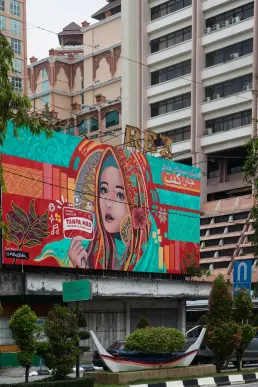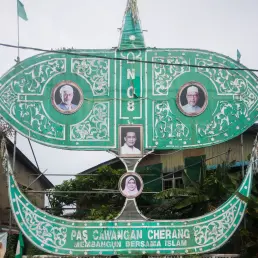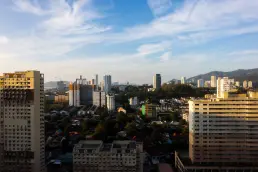I’ve been thinking about the country a lot these past few months. What does it mean to be Malaysian? This is such a simple question that invites so many answers. We usually get surface-level answers on diversity, multiculturalism and unity. At this point, almost seventy years into our formation, these adjectives ring hollow. Our politics don’t reflect multiculturalism. Neither does it inspire unity. Nor does it value diversity. There seems to be, as is part of a global trend, for polarisation to a defining character of what it means to live in the 21st century.
Almost seventy years on, we still have hangups over the core question of this nation. Who are we? We’re many things. But we just don’t know how to talk about it. So, we fight because fighting is the natural expression of when words fail. When the only vocabulary left to communicate is anger and fear. But when we fight, we forget what we’re trying to find the answer to. Because naturally, that’s how fighting works. Arguments, very heated ones, are rarely coherent. They’re an interweaving thread of scores: some recent, some from a long time ago. Anger and fear are good at clouding judgment. They’re also good at distracting us from the good.
This is where we are right now. This is what Malaysia is, almost seventy years into the postcolonial national project of learning how to live together.

A year ago, I was given the opportunity to join a fascinating research project. It was about Malay youths and how they saw themselves and the country.
It isn’t an understatement to say that the Malay question has always fascinated me. For years, I grappled with my identity as a Bumiputera-Malay. Politics, especially liberal politics, often took sport in pegging down the Malays. Sometimes, even the Malay elite themselves took pleasure in denigrating the Malays. Lazy, forgetful, superstitious, petty, vengeful. Mahathir’s magnum opus, The Malay Dilemma, which the country’s former premiere published in 1970, relied on colonial-era tropes1Mohamad, M. (2008) The Malay Dilemma. Marshall Cavendish Corp.. It was impactful because it shaped how Malays thought about themselves and how non-Malay communities were supposed to think about the Malays.
So negative are the associations with Malayness that the newer generation of Malays have instead chosen to embrace their Muslimness2Zaman, D. (2017) When being Malay is no longer good enough, The Malaysian Insight. Available at: https://www.themalaysianinsight.com/s/3534.. Being Muslim was also being part of a global community. It entailed a primordial moral system of living that a more localised Malay identity could not offer. After all, Malayness was a nebulous concept. In entering debates about Malayness, one could stretch as far as the Archipelago (or, as they call it, serumpun) or as localised as the state they live in. Being Muslim, though? It came with a long, well-documented tradition and a history of triumph and civilisation. It was easier to identify oneself as Muslim than it is to explain in clear terms what being a Malay meant.
With this backdrop, I spent the past year going up to the Northern and East Coast states to understand Malayness and its place within Malaysia. Maybe by answering the question of Malayness, one gets closer to understanding the Malaysian question.



In 2008, Fox and Miller-Idriss wrote a paper titled Everyday Nationhood. They argued that an individual’s connection to their nation and ideas of nationhood was shaped primarily by their environment3Fox, J.E. and Miller-Idriss, C. (2008) ‘Everyday nationhood,’ Ethnicities, 8(4), pp. 536–563.. This means that community, material conditions, media, and immediate landscape would shape how they connected to what it meant to be part of their nation and how they understood themselves. This is keenly reflected in our politics; the meanings of Malaysianess are sharply divided across ethnic, religious and even state lines.
The blurry idea of what it means to be part of this nation called Malaysia is unified through media, which political scientist Benedict Anderson described in Imagined Communities—one of the social science’s more prominent texts exploring nationalism and the creation of modern nation-states4Anderson, B. (2006) Imagined communities: Reflections on the Origin and Spread of Nationalism. Verso Books.. We know what it means to be Malaysian in the more abstract concept: that we live within an imagined border and are bound by a legal system and a unified, heavily edited reading of history. But while we collectively agree on the legal definitions of being a Malaysian citizen, how we imagine and carve out our aspirations for the country is shaped entirely by how we experience our environments.



Over the past year, I spent time in the Northern states (Perlis, Kedah and Pulau Pinang) and the East Coast (Kelantan and Terengganu). Except for Pulau Pinang, these states are popularly known as the Malay Heartland due to their high Malay population and were historically the battlegrounds for Umno and PAS5Epi, Z. (2022). Battle for supremacy in Malay heartland, BN gaining ground. Malay Mail. Available from: https://www.malaymail.com/news/malaysia/2022/11/16/battle-for-supremacy-in-malay-heartland-bn-gaining-ground/40038.. Much of Malaypolitik is defined by the political discourse between Umno and PAS, the former positioned as nationalists and the latter Islamists. In recent decades, Umno attempted to close the gap between Malay nationalism and Islam and made efforts to Islamicise Malaysia through policy and development. In the 15th General Elections and 2023 state elections, Perikatan Nasional (PN) won support from the electorate in Northern states and the East Coast6Tee, K. (2023). In 2023, GE15’s political battle and Perikatan’s rise continued in six state elections, four by-elections. Malay Mail. Available from: https://www.malaymail.com/news/malaysia/2023/12/30/in-2023-ge15s-political-battle-and-perikatans-rise-continued-in-six-state-elections-four-by-elections/109633.. The Northern state sweep is significant as it signals the Malay community losing confidence in Umno, once the nation’s most powerful party.
In these elections, the Malay youths also became instrumental in Perikatan’s rise to prominence, with the coalition’s promise of truer Islamic governance being one of the strongest factors for their appeal7Chai, J. (2023). Young Hearts and Minds: Understanding Malaysian Gen Z’s Political Perspectives and Allegiances. ISEAS – Yusof Ishak Institute, (7), pp.1–41.. At this junction, it becomes easy to assume that the support for Perikatan also means that the youths are inclined to sideline their non-Malay neighbours. This is a narrative peddled by many and has stretched as far as the popularising of the term “Green Wave”, which became a dog whistle for the Malay-Muslim support for broader Islamisation. However, it is more accurate to understand the “Green Wave” phenomenon as driven by majoritarian sentiment, as opposed to stated support for an Islamiscised Malaysia8Chan, N. and Hew, W.W. (2023). The Green Wave as a Right-Wing Turn in Malay-Muslim Majoritarianism. Stratsea. Available from: https://stratsea.com/the-green-wave-as-a-right-wing-turn-in-malay-muslim-majoritarianism/.. What this means is that it is a political decision reacting to changes in the sociopolitical environment instead of being inherently driven by deep-rooted ideology.
These states were necessary to understand why there was this evolution in electoral decision-making. And more importantly, what issues drove this change. I walked into this study expecting this trajectory to be driven mainly by political developments. But being there, in these states, offered me a view into the environment and material realities that shaped these decisions. It gave me a window into understanding why the Malay heartland adopted certain beliefs of what it meant to be Malaysian, especially in the context of a supposed multicultural Malaysia.

Non-Malays as minorities
It is important to stress that outside the urbanised West Coast states, such as the Klang Valley (Selangor and Kuala Lumpur), Pulau Pinang, Johor, and Perak—states in Peninsular Malaysia are predominantly Malay. This shapes the Malay community’s views of a multicultural society. The simplified graph below shows the percentage composition of the Bumiputera-Malay and non-Malay populations across the Peninsular states. The graph alone indicates that the more urbanised states also have a sizeable non-Malay population. The inverse is also true where the less urbanised states, primarily the Northern and East Coast states, have a large Malay population. At this junction, I must stress that there a historical link between urbanisation levels and racial composition. I will delve further into how levels of urbanisation, alongside this racial composition, may shape the Malays’ views on multiculturalism at some other time.
If we return to the concept of everyday nationalism or how the everyday and localised environment shapes one’s ideas of nationhood, it becomes easier to understand where the strong views on the place of non-Malay minorities originate from. These are communities where their non-Malay neighbours are a minority and are unlikely to be in significant positions apart from commerce or retail. In some cases, like Kelantan or Terengganu, the non-Malay (Chinese) community had assimilated into the larger Malay culture. These are states where the non-Malays are definitively a minority and are either not a political threat or have genuinely adapted into a Malay-majority cultural environment.
Therefore, when non-Malay communities in the West Coast states, such as the Klang Valley or Pulau Pinang, visibly advocate for equal rights or push back against Islamisation, this is seen as an upset. Many Malay youths I met often expressed concern and dissatisfaction against West Coast Chinese communities, which they believed were insular, extremely resistant to assimilation and were actively reshaping Malaysia into an image that deviated from the Malay-Muslim sociocultural norm. After all, the Malay communities inhabited an environment where minorities were either compliant or non-combative; the West Coast Chinese, by comparison, were deemed selfish and had little respect for this “harmonious” idea of Malaysia.
However, despite this view, the Malay youths believed firmly in the Malaysian ideal of multiculturalism—dependent as it is on non-Malay compliance.

The idea of a multicultural Malaysia
What does multiculturalism look like? How should it? The Malaysian cultural debate often oscillates between the allure of assimilation, as practised by our Thai and Indonesian neighbours, or multiculturalism of the British nature, which we adopted from our colonial administrators. This isn’t an exclusive discourse. Even in the United Kingdom, the merit of multiculturalism is under interrogation. Last year, UK former home secretary Braverman said in a speech that “Multiculturalism makes no demands of the incomer to integrate. It has failed because it allowed people to come to our society and live parallel lives in it. They could be in the society but not of the society.”9Wingate, S. (2023). Braverman: Multiculturalism has ‘failed’ and threatens security. The Independent. Available from: https://www.independent.co.uk/news/uk/europe-home-secretary-united-states-multiculturalism-prime-minister-b2418911.html
This rhetoric is familiar to anyone, even those mildly aware of Malaysian public discourse in the past decade. Even as recent as a few months ago, former premier Mahathir Mohamad, on a political podcast, ruminated about the missed opportunity for non-Malays to assimilate into the larger ‘Bangsa Malaysia’ ideal10Tee, K. (2023). Citing Indonesia, Dr Mahathir says non-Malays should be assimilated and ‘become Malays’ as part of ‘Bangsa Malaysia’. Malay Mail. Available from: https://www.malaymail.com/news/malaysia/2023/11/13/citing-indonesia-dr-mahathir-says-non-malays-should-be-assimilated-and-become-malays-as-part-of-bangsa-malaysia/101791.
In broader public discourse, there is growing discontent from the Malay community towards the non-Malays, specifically the Chinese, in what is seen as ‘living parallel lives’. The push for recognising the Unified Examination Certificate (UEC) as a validation of Chinese vernacular education. The non-proficiency and rejection of the national language while simultaneously prioritising Mandarin. These are transgressions of a thousand cuts accumulated over decades. May 13th, 1969, exemplifies the worst of this discourse—socioeconomic and political anxieties erupting into bloodshed. Yet, it is the national trauma we do not talk about. It has been fifty-five years, and the racial riots remain a spectre. And so, the tension remains.



So, what does multiculturalism look like in practice? As it is now, Malaysians are living parallel lives with very different ideas of nationhood. In urban Malaysia, multiculturalism is more salient, as seen in inter-ethnic friendships and the porosity of cuisines. After all, how best is multiculturalism reflected if not in the food shared? This is perhaps a cliché that has some grounding in truth. However, it is also in urban Malaysia where the divide is sharply cut, with specific neighbourhoods and commercial centres more obviously race-leaning. Townships like Bangi and Shah Alam are transparently Islamic, while parts of the Klang Valley, like Kepong and Puchong, are decidedly Chinese.
Our education system also reflects this multi-polarity, with our schools cutting across the class, race and religion. Malaysian children funnel through these different channels and end up in adult life with varying ideological outlooks as to what Malaysia looks like. A Malaysia where Malay Muslims are at the political apex. A Malaysia where non-Malays are second-class citizens and must work hard to achieve their socioeconomic destinies. A Malaysia where Malay-Muslim hegemony is under incremental threat. A Malaysia where conservative Islam is taking over public and economic life.
Our lives are parallel because the way we live is also parallel. We talk across each other, but not with each other.

So, is nationhood defined by uniformity or parallel but complementary lives? As we come close to sixty-one years of Malaysia—we have yet to resolve the meaning of national belonging.
Clearly, it isn’t enough to negotiate, as our forefathers once did. We have developed a zero-sum mentality where political dominance is the goal. Because political power is a means of transforming reality through law and policy. Negotiation doesn’t work in zero-sum environments. Only the looming eventuality of violence does. Because violence is the only language left when anger and fear are left unheard and unaddressed for so long. And in Malaysia, everyone feels themselves a victim.